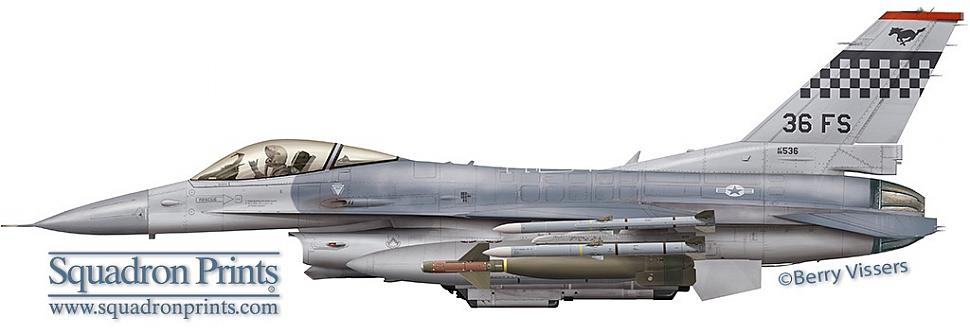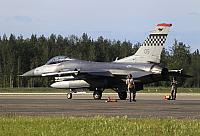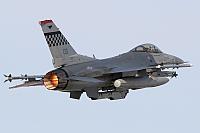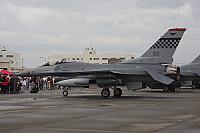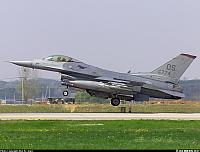 |
36th Fighter Squadron ( USAF PACAF)" Flying Fiends" |
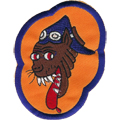 |
36 FS " Flying Fiends" ( USAF PACAF) | |||
| Status: |
Active
|
|||
| Version: | F-16C/D block 40 | |||
| Role: | Air Defense | |||
| Tailband: | Red | |||
| Motto: | The Night Time is the Right Time | |||
| Badge: | N/A | |||
F-16 History
In an effort to modernize the last part of fighter units in the Pacific theatre the USAF decided on reequipping the 36th TFS in 1988. The unit started receiving block 30 airframes in 1988. They replaced the F-4E Phantom fighters that flew with the squadron for 10 years. The squadron was tasked with air defense of the Korean peninsula, together with the resident Korean squadrons.
Only one and a half year after the introduction of the F-16 into the squadrons’ fleet, the unit changed types. In 1990 factory fresh block 42s were introduced. Although this type features some advanced settings concerning targeting and attacking enemy targets, the main mission of the squadron remained the same, being air defense of South Korea. Although evidently a conventional attack mission was added to the squadrons mission profile. The introduction of the block 42 was quite odd however. All F-16s that were operational in the Pacific theatre were equipped with the General Electric F110 engine instead of the Pratt & Whitney F100 engine. This setup resulted in the squadron being somewhat hampered since a separate supply chain had to be established specifically for them.
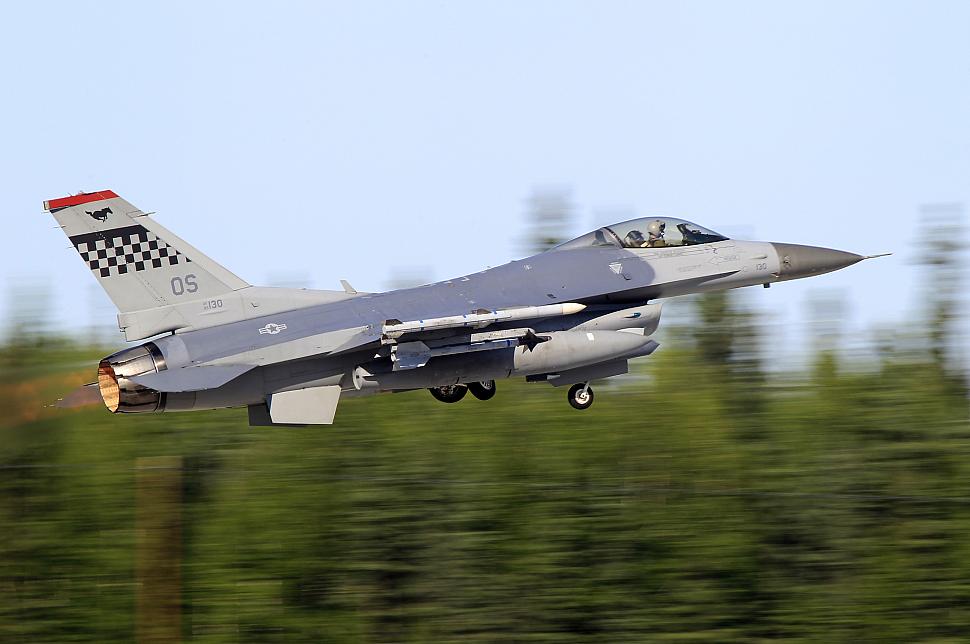
At first this wasn’t much of a problem since the Koreans were flying F100 equipped F-16s and so enough expertise remained in-country. Moreover the squadron was the sole flying the F-16 within the 51st FW. However, the USAF decided to standardize the fleet and in 1994 the squadron received a batch of block 40 airframes. With this move the airframes came in line with the entire Pacific fleet reducing maintenance costs and associated supply chain costs. This switch didn’t change anything about the units' operational mission and commitments.
Aircraft Markings History
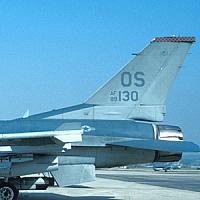
The tail consist of a black and red checkered tailband with the 'OS' tailcode in the center - meaning Osan - and the serial underneath with the PACAF logo above the tailcode.
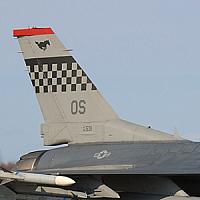
The design was changed completely with the tailband changing to a full red one. The tail code was moved much further down below and a large band with a checkerboard of black with a strip across the top of the checkers was added in the center of the tail. In between the checkerboard and the tail band is a galloping black horse. The heritage of this tail band goes back to the Korean War.
Unit History
- 1917: Activation of the squadron in Camp Kelly, Texas
- 1917: No aircraft assigned (part of 3 AIC)
- 1917: No aircraft assigned (Etampes [Fr.])
- 1917: No aircraft assigned (Issoudun [Fr.])
- 1918: No aircraft assigned (Cazaux [Fr.])
- 1918: No aircraft assigned (St. Jean-de-Monts [Fr.])
- 1919: No aircraft assigned (St. Nazaire [Fr.])
- 1919: No aircraft assigned (Garden City, New York)
- 1919: Disbanded
- 1930: Activation of the squadron in Selfridge, Michigan
- 1930: P-6 'Hawk' (part of 2 BW)
- 1931: P-6 'Hawk' (part of 8 PG)
- 1931: P-6 'Hawk' (part of 18 PG)
- 1932: P-12 (part of 8 PG, Langley Field, Virginia)
- 1936: P-30
- 1939: P-36 'Hawk'
- 1940: P-40 'Warhawk' (Mitchell Field, New York)
- 1941: P-39 'Airacobra'
- 1942: P-39 'Airacobra' (Brisbane [Aus.])
- 1942: P-39 'Airacobra' (Lowood [Aus.])
- 1942: P-39 'Airacobra' (Townsville [Aus.])
- 1942: P-39 'Airacobra' (part of 8 FG, Port Moresby [N. Gui.])
- 1942: P-39 'Airacobra' (Townsville [Aus.])
- 1942: P-39 'Airacobra' (Milne Bay [N. Gui.])
- 1943: P-47 'Thunderbolt' (Mareeba [Aus.])
- 1943: P-47 'Warhawk' (Port Moresby [N. Gui.])
- 1943: P-47 'Thunderbolt' (Nadzab [N. Gui.])
- 1944: P-47 'Warhawk' (Finschhafen [N. Gui.])
- 1944: P-38 'Lightning' (Nadzab [N. Gui.])
- 1944: P-38 'Lightning' (Owi [Indo.])
- 1944: P-38 'Lightning' (Morotai [Indo.])
- 1944: P-38 'Lightning' (Dulag [Phil.])
- 1944: P-38 'Lightning' (San Jose [Phil.])
- 1945: P-38 'Lightning' (Fukuoka [Jap.])
- 1946: P-38 'Lightning' (Ashiya AB [Jap.])
- 1946: P-51 'Mustang' (Itazuke AB [Jap.])
- 1947: P-51 'Mustang' (Ashiya AB [Jap.])
- 1949: P-51 'Mustang' (Itazuke AB [Jap.])
- 1950: P-80C 'Shooting Star' (part of 8 FBG, Tsuiki AB [Jap.])
- 1950: P-80C 'Shooting Star' (Suwon AB [S. Kor.])
- 1950: P-80C 'Shooting Star' (Kimpo AB [S. Kor.])
- 1950: P-80C 'Shooting Star' (Pyongyang [N. Kor.])
- 1950: P-80C 'Shooting Star' (Seoul AB [S. Kor.])
- 1950: P-80C 'Shooting Star' (Itazuke AB [Jap.])
- 1951: P-80C 'Shooting Star' (Kimpo AB [S. Kor.])
- 1951: P-80C 'Shooting Star' (Suwon AB [S. Kor.])
- 1953: F-86F 'Sabre'
- 1954: F-86F 'Sabre' (Itazuke AB [Jap.])
- 1957: F-100D/F 'Super Sabre'
- 1958: F-100D/F 'Super Sabre' (part of 8 TFW)
- 1963: F-105D 'Thunderchief'
- 1964: F-105D 'Thunderchief' (part of 41 AD, Yokota AB [Jap.])
- 1964: F-105D 'Thunderchief' (Korat AB [Thai.])
- 1965: F-105D 'Thunderchief' (part of 6441 TFW, Takhli AB [Thai.])
- 1966: F-105D 'Thunderchief' (part of 41 AD)
- 1966: F-105D 'Thunderchief' (part of 347 TFW, Osan AB [S. Kor.])
- 1967: F-4C 'Phantom II'
- 1971: F-4D 'Phantom II' (part of 3 TFW, Kunsan AB [S. Kor.])
- 1971: F-4D 'Phantom II' (Osan AB [S. Kor.])
- 1974: F-4D 'Phantom II' (part of 8 TFW)
- 1974: F-4E 'Phantom II' (part of 51 TFW)
- 1988: F-16C/D 'Fighting Falcon'
- 1992: F-16C/D 'Fighting Falcon' (part of 51 FW)
- 1994: F-16C/D 'Fighting Falcon' (part of 51 OG)
F-16 Airframe Inventory
- All 36 FS F-16s in our F-16 Aircraft Database (past and current aircraft)
- Current 36 FS F-16s in our F-16 Aircraft Database
Photos
Please use this form to add any list any error or omissions you find in the above text.
Note: your comments will be displayed immediately on this page. If you wish to send a private comment to the webmasters, please use the Contact Us link.

